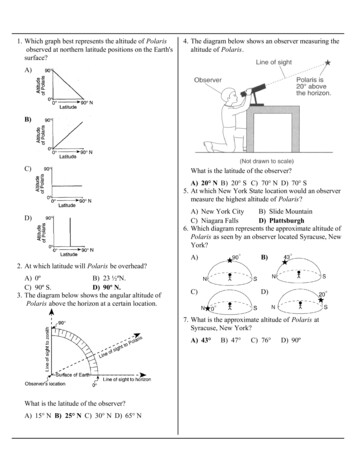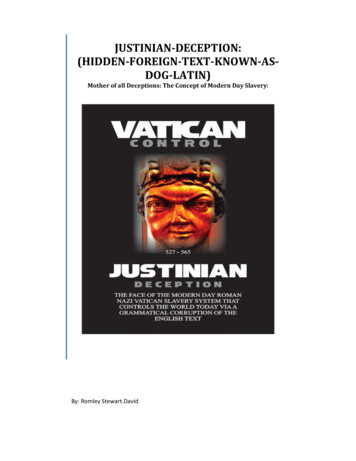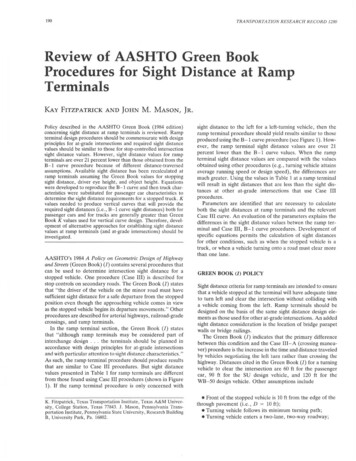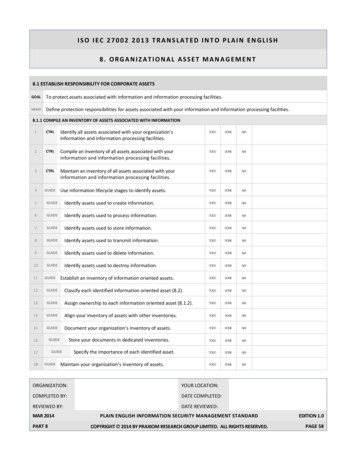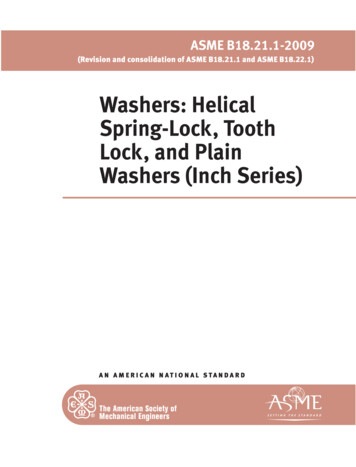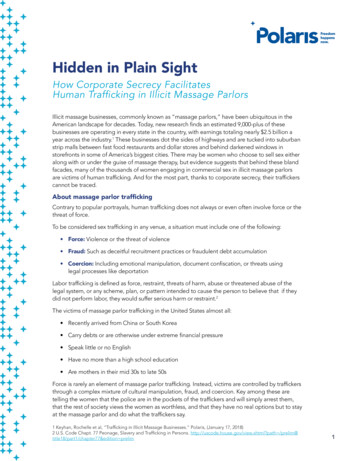
Transcription
Hidden in Plain SightHow Corporate Secrecy FacilitatesHuman Trafficking in Illicit Massage ParlorsIllicit massage businesses, commonly known as “massage parlors,” have been ubiquitous in theAmerican landscape for decades. Today, new research finds an estimated 9,000-plus of thesebusinesses are operating in every state in the country, with earnings totaling nearly 2.5 billion ayear across the industry.1 These businesses dot the sides of highways and are tucked into suburbanstrip malls between fast food restaurants and dollar stores and behind darkened windows instorefronts in some of America’s biggest cities. There may be women who choose to sell sex eitheralong with or under the guise of massage therapy, but evidence suggests that behind these blandfacades, many of the thousands of women engaging in commercial sex in illicit massage parlorsare victims of human trafficking. And for the most part, thanks to corporate secrecy, their traffickerscannot be traced.About massage parlor traffickingContrary to popular portrayals, human trafficking does not always or even often involve force or thethreat of force.To be considered sex trafficking in any venue, a situation must include one of the following: Force: Violence or the threat of violence Fraud: Such as deceitful recruitment practices or fraudulent debt accumulation Coercion: Including emotional manipulation, document confiscation, or threats usinglegal processes like deportationLabor trafficking is defined as force, restraint, threats of harm, abuse or threatened abuse of thelegal system, or any scheme, plan, or pattern intended to cause the person to believe that if theydid not perform labor, they would suffer serious harm or restraint.2The victims of massage parlor trafficking in the United States almost all: Recently arrived from China or South Korea Carry debts or are otherwise under extreme financial pressure Speak little or no English Have no more than a high school education Are mothers in their mid 30s to late 50sForce is rarely an element of massage parlor trafficking. Instead, victims are controlled by traffickersthrough a complex mixture of cultural manipulation, fraud, and coercion. Key among these aretelling the women that the police are in the pockets of the traffickers and will simply arrest them,that the rest of society views the women as worthless, and that they have no real options but to stayat the massage parlor and do what the traffickers say.1 Keyhan, Rochelle et al, “Trafficking in Illicit Massage Businesses.” Polaris, (January 17, 2018)2 U.S. Code Chapt. 77 Peonage, Slavery and Trafficking in Persons. http://uscode.house.gov/view.xhtml?path /prelim@title18/part1/chapter77&edition prelim1
Illicit Massage Parlors and Corporate SecrecyWhat is unique about this form of trafficking is that massage parlor traffickers actually go throughthe process of registering their businesses as if they were legitimate.Conceivably then, it should be relatively simple to determine the basics about these businesses —such as what products or services they provide and who ultimately controls and makes money fromthe business. The actual or “beneficial” owner would then in most cases be the trafficker and couldbe prosecuted as such.In reality, the laws governing business registration are almost tailor-made for massage parlortraffickers to hide behind. Neither states nor the federal government require people setting upcompanies to include the name of the actual owner of the business in the registration paperwork.What is actually required depends on the jurisdiction. Sometimes the owner’s name is left blank.Sometimes it is filled in with the name of a registered agent or someone else paid to be the frontperson or point of contact. Sometimes the business is registered under the name of an anonymousshell company — another business that exists in name only but has no actual assets.3 All of thisobfuscation is perfectly legal.In reality, the laws governing business registration are almosttailor-made for massage parlor traffickers to hide behind.The figure of 9,000 illicit massage businesses operating across the country, first reported in Polaris’srecently released report, “Human Trafficking in Illicit Massage Businesses,” was difficult to comeby because of these lax or nonexistent corporate transparency laws. It took extensive research,including cross-referencing publicly available datasets with websites on which commercial sexpurchasers leave reviews of their sexual experiences at these illicit businesses, to arrive at thisminimum figure.It is hard to escape the irony here: Someone looking to purchase commercial sex from an illicitmassage parlor can log in to any number of review boards and, sometimes for a small fee, getgraphic descriptions of individual women’s bodies and specific sexual experiences with thosewomen. Meanwhile, while the businesses themselves are easy to find, the privacy of the actualowners of the businesses where these sexual acts take place is scrupulously protected by U.S. law.Irony aside, the fact that the United States is among the easiest country in the world in which tohide who actually owns and benefits from a business4 is part of the reason why massage parlortrafficking is so difficult to prosecute criminally. There are legitimate reasons why some businessesuse anonymous shell companies and there is no reason why they cannot continue to do so. But ifwe are to end human trafficking in massage parlors, we must begin by lifting the veil of secrecy thatprotects the criminals who profit from it.3 Staff, I. (2003, November 26). Shell Corporation. Investopedia. Retrieved from on.asp#ixzz4vPwXidD4 Findley, Michael et al. “Global Shell Games: Experiments in Transnational Relations, Crime, and Terrorism.” CambridgeUniversity Press (March 24, 2014), Page 74. http://bit.ly/2uTLptQ .2
Who Actually Owns Massage ParlorsPolaris analysts used open-source data5 to examine over 9,000 illicit massage parlors and theirnetworks across the country to find ownership information. Of the more than 6,000 illicit massage businesses for which Polaris found businessrecords, only 28 percent of these illicit massage businesses have an actual personlisted on the business registration records at all. Only 21 percent of all the business records found for illicit massage parlors actuallyspecifically name the owner — although even in those cases, there is no way to knowfor sure if that information is legitimate.Why corporate transparency matters in massage parlor traffickingMost illicit massage parlors are part of an organized crime network. Generally, these networksinclude at least one other illicit massage parlor as well as non-massage venues such as nail salons,restaurants, grocery stores, and cleaners.Criminal networks are necessary in large part for laundering money from the illicit massage parlors.These businesses generally operate out in the open, paying taxes and otherwise taking stepsto avoid drawing attention to the true nature of the operation. A hallmark of an illicit massagebusiness is that it advertises services at significantly lower rates than is the standard. For example,an illicit massage parlor will charge 40 for a one hour massage in a jurisdiction where a therapeuticmassage performed by a licensed massage practitioner averages between 80 and 100 an hour.Of course, the 40 advertised price is just a baseline price. The real price is negotiated and paidbased on the specific sexual act requested and performed.A tax auditor would notice the discrepancy between what the business charges and the far higheramount the business actually brings in. To avoid detection, the business owner spreads thesuspicious profits out to other businesses in the network.If the businesses were all registered under the name of the person who actually owned them— for example, “John Q. Smith,” the connections would be clear and the money launderingoperations obvious. Because many of the businesses are registered anonymously, as shellcompanies (“Massage LLC” for example), or in the name of someone other than the actual owner,these connections are often missed, along with the opportunity to prosecute and shut down thesehuman trafficking venues.Historically, victims of massage parlor trafficking have been the main target of law enforcementactivity, while the owners of the businesses — the traffickers — fly under the radar. Typical lawenforcement activity around illicit massage parlors has involved raids in which officers sweep intothe facility and arrest everyone on the premises. These raids are highly unlikely to net the actualowners of the businesses, as they are rarely on site or even necessarily involved in the day-to-dayoperations of the massage venues. That is left to managers (often referred to as “mamasan”), andsometimes a manager-in-training (someone who is still primarily selling sex, but who has begunassisting management in controlling victims).Raids focusing on employees are antithetical to efforts to shut down human trafficking. First ofall, vice raids don’t do much to slow profits from these businesses. If a single venue in a criminalnetwork is shut down, the trafficker is still pulling in profits from the other venues, and can simply5 For a full list of open-source data used, please see methodologies section of full report at ing3
The frequent arrests of victims — not owners —strengthens the traffickers hold on the women,demonstrating their power while underlining thevulnerability of the victims they control and rotate atwill. The traffickers routinely tell the women under theircontrol that they have no options for seeking assistanceonce they become involved in the massage parlorworld. They are told that police see them as prostitutes,not as victims, that they are considered trash, and thatno one will help them out of their situations. When thewomen are then swept up in police raids, the traffickersare proven right.To effectively and sustainably target massage parlortrafficking, law enforcement must undertake organizedcrime investigations, which focus on ownership bylooking into money laundering or tax evasion. Thiswould shut down entire networks, meaning that thewomen could not simply be moved around until thepolice interest had calmed down. Such prosecutionswould not only punish perpetrators, but also send astrong signal that human trafficking in massage parlorsis no longer a low-risk, high-profit venture, as it is widelyseen today. Flipping the perception of the risk versusthe reward of human trafficking in these and othervenues is key to ending the proliferation of the crime.Unfortunately, the ability of businesses to obscureownership and therefore network ties, makes itincredibly time-consuming and resource-intensive,and sometimes impossible, for law enforcement toundertake such investigations.San Francisco SpaObscures Ownership7Shell companies are intended to makeit difficult to discover true businessownership. One spa in San Francisco,CA, provides a good example ofhow confusing a purposely obscuredbusiness organization can be. Thephone number and address for thespa, listed on the massage parlorreview site RubMaps, also belongto a business bearing an individual’sname. That business is classified underthe Standard Industrial Classification:Religious Organizations (prettyunusual for a religious organizationto be linked to a spa!). And it isn’t theonly linked business. The spa’s phonenumber is also connected to anotherbusiness in Los Angeles with a nameadvertising sexual products (classifiedunder Miscellaneous Retail Stores), aswell as a residential address in LA.CASE STUDYtransfer the victims to another massage parlor. Rotatingvictims between businesses in the network, or withinother networks in sharing agreements, is routine inmassage parlor trafficking. This rotation process keepsthe victims disoriented and makes them therefore easierto control while also ensuring buyers at a particularlocation have a steady supply of new women to choosefrom. On average, traffickers rotate victims between thebusinesses every 2-6 weeks.6While there is no listed point ofcontact for the shell company, theaddress and phone number are that ofthe original advertised illicit massagebusiness. The business name is alsoan alias for the name of the owner ofthe illicit massage business listed onRubMaps. Having a shell companyregistered at the same address as anillicit massage business facilitates themovement of illicitly gained funds, andallows the spa to keep its reportedannual income under a figure thatwould raise red flags. Additionally, anyincome the shell company earns thatexceeds the reported annual incomecan be passed off as donations, andbecause the spa is registered underReligious Organizations, the businessowners can qualify for different taxbreaks that normal small businessesdo not receive.7 Keyhan, Rochelle et al, “Traffickingin Illicit Massage Businesses.” Polaris,(January 17, 2018)6 Rotation can vary by geographic region. This figure is based on conversations between Polaris and partner city lawenforcement and prosecutors between January 2015 and April 2016. (See Methodology, p. 87 of this report).4
Code Enforcement and Human Trafficking in Massage ParlorsAlong with organized crime investigations and prosecutions, the most powerful tools forshutting down massage parlor trafficking are strong state and local civil laws that regulate howthe businesses operate. For example, laws that require massage businesses to have front-doorentrances can deter customers, who are often accustomed to frequenting illicit massage parlorswith rear entrances, if they think they might be seen or noticed entering such an establishment byothers in their community.Enacting and enforcing such laws is among the most effective ways to shut down massage parlortrafficking and incorporation transparency is a necessary element. It is difficult to enforce civil codeif the enforcing agency cannot identify the person who is actually responsible for paying a fine, orremediating a building issue.Also worth nothing is that effective enforcement requires that businesses actually register that theyare, in fact, massage businesses. Today, massage parlors can — and do — register as nail salons,modeling studios — whatever they want. This dishonest self-classification allows them to avoidregulations that would make it difficult for them to conduct illicit business.For example, in Houston, many illicit massage parlors registered as modeling studios until the cityrewrote its local ordinance to close this loophole.8 In particularly egregious cases, traffickers registerunder unrelated industries such as religious organizations or educational institutions, making themeligible for tax breaks.Again, it is hard to enforce rules requiring honest and accuracy in business registration if there is nota human being responsible for the business that anyone can find and hold accountable.Unfortunately, even after a city or county closes the loopholes in its ordinance, traffickers haveoptions. They can — and do — simply move to the next town over, where the regulations are still lax.Preventing regulation shopping will take a concerted, nationwide effort at the state and local level.8 Massage Establishment Ordinance « Human Trafficking Houston. (n.d.). Retrieved November 12, 2017,from e-establishment-ordinance-toolkit/5
RecommendationsRequiring transparency around business ownership for law enforcement purposes is key to endingtraffickers’ ability to hide their networks and cash flow.Both state and federal laws should: Require businesses to register official operators and primary owners (aka asthe beneficial owner, partner, etc.), all of whom should be required to provide a validphone number and address and a unique identifying number from a non-expired U.S.passport, a non-expired U.S. state identification card or driver’s license, or a nonexpired passport issued by a foreign government. Require that covered entities file annual reports of beneficial owners andprovide updates to the government within 60 days of any change in the name or otherinformation previously disclosed about a beneficial owner or in the list of people whoare beneficial owners. Provide state, local and federal law enforcement with direct access to this information Impose criminal and civil liability for failure to report beneficial ownership information. Hold the official operator listed on all registration records legally liable forthe business, unless it can be confirmed that the listed operator is a victim who wascompelled to list herself as an operator.The U.S. Congress is currently considering several bipartisan pieces of legislation that meet thesestandards.9Pending proposals differ on how information on beneficial ownership would be collected and stored.Options include having states collect the information or putting the responsibility on FinCen, theFinancial Crimes Enforcement Network, a bureau of the U.S. Department of the Treasury. There arepros and cons to each approach. States already have forms for corporate registration so the transitionwould be somewhat smoother. The FinCEN approach would house all the information in a singleplace, which could potentially make it easier for law enforcement to access in a timely manner.With comprehensive federal legislation setting the standards for incorporation by which federal lawsand tax liability are applied, state and local law enforcement investigating massage parlor traffickingnetworks will have the ability to more easily follow the money and build strong organized crimecases. And most importantly, traffickers will no longer have the strong incentive of a system thatallows them to obscure their illicit activities.9 Legislation pending as of 4/1/2018 that meets these standards includes H.R.3089, introduced 6/28/2017 by Reps. CarolynMaloney (D-N.Y.) and Pete King (R-N.Y.) and S.1454, introduced 2/6/2018 by Sens. Sheldon Whitehouse (D-R.I.) and ChuckGrassley (R-IA)6
an illicit massage parlor will charge 40 for a one hour massage in a jurisdiction where a therapeutic massage performed by a licensed massage practitioner averages between 80 and 100 an hour. Of course, the 40 advertised price is just a baseline price. The real price is negotiated an
